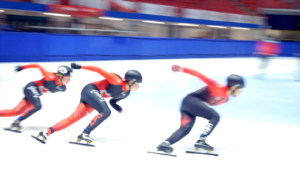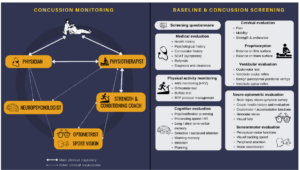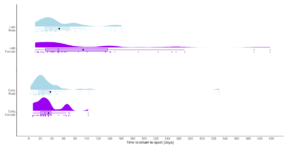Keywords: Multidisciplinary care, Olympic sports, return to sport
Sport-related concussion is an injury that has received significant scientific attention in recent decades, with direct impacts on sports rules and policies. Surprisingly, very few studies, if any, have focused on concussion in Olympic athletes. After years of data structuring at the medical clinic of the Institut national du sport du Québec, a Canadian national Olympic and Paralympic training center, our medical and research team has focused on the recovery duration of Olympic athletes following a concussion, particularly in relation to the access to multidisciplinary care. This blog summarizes the findings of our study published in BJSM.
The reality of Olympic athletes
Olympic athletes represent a unique population within the elite sports ecosystem: they are considered “elite amateurs” but train full-time, have different access to resources compared to collegiate or professional athletes (even though they sometimes overlap with the latter), and travel extensively internationally to participate in their competitions (e.g., World Cups, World Championships, Olympics). Additionally, they are not always centralized. This makes their monitoring more complicated and rarely studied.

Why is this study important?
The majority of studies on sport-related concussion focus on collegiate and professional athletes and show that recovery duration has increased following the implementation of rigorous return-to-sport protocols, with the current average recovery time estimated at around 16 days.1–3 However, most of these studies come from North America and involve populations with very efficient access to care (e.g., 1 day). On the other hand, studies on populations with reduced access to care show that delayed access prolongs recovery time (e.g., 30 days).4,5 Additionally, there are injury modifiers that could influence recovery duration, such as a history of concussions, initial symptoms, or sex.4,6 Given this context and the specific constraints of Olympic athletes, it was important for us to learn more about their recovery following a concussion.
How did the study go about this?
We studied a cohort of 133 Olympic athletes sustaining at least one concussion over a 4-year period, representing an Olympic quadrennial. These athletes were compared based on whether they accessed multidisciplinary care within 7 days of their injury or waited longer than 7 days. Additionally, the characteristics of the athletes’ concussion were examined. The typical pathway for the athletes at our medical consisted of an initial visit to either a sports medicine physician or their team sports therapist. A sports medicine physician confirmed the diagnosis and provided referrals. Rehabilitation progression was based on the evaluation of exercise tolerance, with priority given to returning to cognitive tasks and providing additional targeted support based on clinical findings of a cervical, visual, or vestibular nature as you can see on the figure 1 below. The expert team worked in an integrated manner with the athlete and their coaching staff during the rehabilitation phase.

Figure 1: Concussion monitoring
What did the study find?
A total of 160 sport-related concussion were observed in our sample with a median time to return to sport of 34 days for Olympic athletes, which is significantly longer than the time reported for other groups of athletes (e.g., professionals, collegiate) who benefit from more centralized resources or travel less internationally. The study also showed that athletes who received early care (e.g., ≤7 days) returned to training faster (e.g., 26 days) than those who received late care (e.g., 45 days). Time to return to sport was also associated with the number and intensity of initial symptoms. Additionally, female athletes recovered more slowly when they accessed care too late (e.g., >7 days) as you can see on figure 2 below showing the time to return to sport as a function of group and sex.

Figure 2: Time to return to sport
What are the key take-home points?
This study highlights the importance of early access to care for Olympic athletes. It is essential that sports authorities and federations implement effective care systems, particularly during international competitions, to ensure rapid and optimal recovery for Olympians.
Author and affiliations:
Thomas Romeas, Félix Croteau, Suzanne Leclerc
Sport sciences and medicine, Institut national du sport du Québec, Montreal, QC H1V 3N7, Canada
thomas.romeas@umontreal.ca
Original study:
Romeas T, Croteau F, Leclerc S. Where is the research on sport-related concussion in Olympic athletes? A descriptive report and assessment of the impact of access to multidisciplinary care on recovery. British Journal of Sports Medicine. Published Online First: 16 July 2024. doi: 10.1136/bjsports-2024-108211
References
- Putukian, M. et al. Clinical recovery from concussion-return to school and sport: a systematic review and meta-analysis. Br. J. Sports Med. 57, 798–809 (2023).
- Patricios, J. S. et al. Consensus statement on concussion in sport: the 6th International Conference on Concussion in Sport-Amsterdam, October 2022. Br. J. Sports Med. 57, 695–711 (2023).
- Liebel, S. W. et al. Sport-Specific Recovery Trajectories for NCAA Collegiate Athletes Following Concussion. Ann. Biomed. Eng. (2023) doi:10.1007/s10439-023-03406-8.
- D’Lauro, C. et al. Reconsidering Return-to-Play Times: A Broader Perspective on Concussion Recovery. Orthop J Sports Med 6, 2325967118760854 (2018).
- Kontos, A. P. et al. Association of Time Since Injury to the First Clinic Visit With Recovery Following Concussion. JAMA Neurol. 77, 435–440 (2020).
- Wang, E. X. et al. Factors associated with a prolonged time to return to play after a concussion. Am. J. Sports Med. 3635465221083646 (2022).